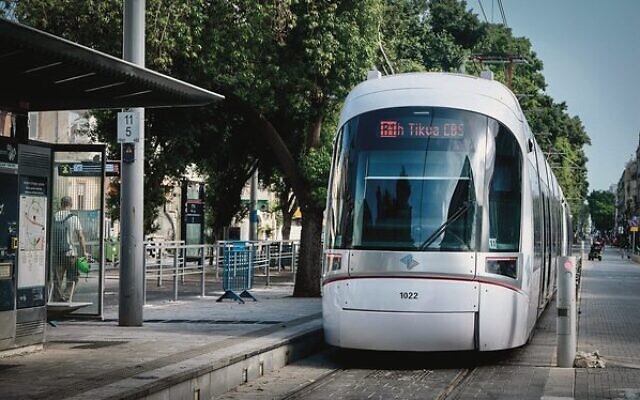Tel Aviv light rail begins operating
The government mass transit agency NTA oversaw the work on the line, which has been under construction since 2015 and cost NIS 19 billion ($A7.8 billion).
(TIMES OF ISRAEL, JTA) – Tel Aviv’s long-awaited light rail began chugging through the city last Friday, with dozens of passengers departing from three stations simultaneously to mark the launch of a system many hope will transform the highly congested region.
Three trains from Petah Tikva Central Station, Kiryat Arye and Bat Yam-Komemiyut departed at 5.40am, officially opening the Red Line, which carries passengers for 24 kilometres from Bat Yam to Petah Tikva across 34 stations.
Work is underway on two additional lines that will triple the area served by light rail, scheduled to be completed in 2026 and 2028. The entire project will ultimately include 139 stations in 14 cities and will eventually be complemented by a three-line regional metro rail.
At a short ceremony in Bat Yam last Friday morning, Tel Aviv resident Koti Elazar, 70, received a certificate as the first passenger ever on the Red Line.
“I arrived specially from North Tel Baruch in order to inaugurate the line. I planned this all a week in advance,” Elazar told the Ynet news site.
Rides were free on Friday, but the light rail system started collecting fares on Saturday night. Trips within Tel Aviv cost 5 shekels ($A2.05) while longer trips to other cities in Gush Dan cost around $A4.60.
“We are happy and excited. We waited a long time for this,” said Bat Yam mayor Tzvika Brot, while also noting the years of messy construction that made the line possible. “The residents bore the brunt of the burden from building the rail over the years, but the result is amazing.”
The government mass transit agency NTA oversaw the work on the line, which has been under construction since 2015 and cost NIS 19 billion ($A7.8 billion).
Last Thursday, Prime Minister Benjamin Netanyahu ceremoniously launched the project, accompanied by shouts from nearby anti-judicial overhaul protesters and amid major traffic blockages across Tel Aviv and its surrounding cities.
The PM cut the ribbon at the opening ceremony at one terminus of the Red Line in Petah Tikva, saying, “This line will serve everyone – those who support us and those who oppose us. This is a festive day for Israel.”
For many residents, one of the key issues clouding the light rail’s inauguration is that it will not run on Shabbat.
Transport Minister Miri Regev’s predecessor, Merav Michaeli, had promised that the line would run on Friday evenings and all day Saturday – a rarity in a country where public transportation does not operate on Shabbat.
Michaeli’s promise prompted outrage in the Charedi city of Bnei Brak, which has several stops on its route. Earlier this month, Regev announced that she was reversing Michaeli’s decision.
Tel Aviv Mayor Ron Huldai skipped the opening ceremony over the Shabbat decision. Some critics of the government’s decision say they plan to boycott the train line altogether until it operates on Shabbat.
On the other six days of the week, the new train line will ease for many Israelis what can be a complicated, congested journey to and through Tel Aviv.
Travelling into the centre of the city from either of the terminuses of the train line can take up to an hour by bus; driving by car, which not all Israelis can do, comes with a hefty price tag for parking – if a spot can even be found. Now, it will take just minutes to traverse the same distance.
Areas served by the new train line are expected to become more desirable for people seeking to beat the city’s high rents.


comments